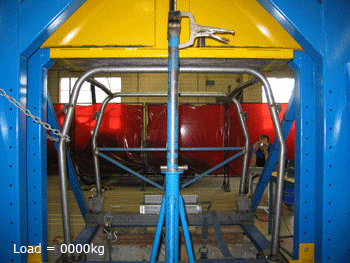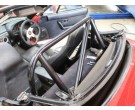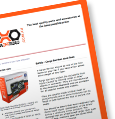Roll over protection
What is a Roll Over Protection Structure (ROPS)?
A Roll Over Protection Structure (ROPS) is a reinforcement member(s) installed in to, or on to a vehicle with the intention of protecting the vehicles occupants in the event of a roll over accident.
The primary intent of a ROPS is to limit the crushing and deformation of the vehicle roof and cabin structure during a roll over accident. This ensures that the vehicle occupants are provided with an adequate amount of survival space which reduces the risk of head, neck/spinal, and upper torso injuries, ultimately preventing death.
Why is a ROPS needed?
Modern production vehicles are designed to meet specific safety standards centred around improving occupant safety. These include seat belts, Supplemental Restraint Systems (Airbags), door latch burst strength, braking performance, and side/frontal impact crumple zone/crash strength. However, these safety features are focused mainly around highway use of sedan type vehicles where roll over is a low occurrence incident.
In contrast to that of a sedan, light commercial and four-wheel-drive vehicles have a much higher centre of gravity (CG). Combined with this, new levels of ride comfort, power, and quietness make it far easier to travel at higher speeds than the equivalent type of vehicle in the past. At these speeds, they have a much higher risk of roll over type accidents in situations where evasive or correct steering action is needed. Added to this, the vehicles tendency to carry higher loads reduces the driver's ability to slow the vehicle before encountering such circumstances.
Testing
For repeatable results, and a standard that one can genuinely compare one rops structure to another, physical testing is the only measure.
In consultation with third party specialist engineers, Brown Davis conducts in house testing with a specially designed test rig developed to replicate very specific roll over loads. The test rig has the capacity to produce a crushing force in excess of 20 tonnes in the vertical axis. Each ROPS unit can be rotated and fixed in many positions, in order to apply load to specific areas of a ROPS structure, from any angle. The data acquired from such testing is used to correlate and validate data obtained in FEA (Finite Element Analysis) testing.

The Brown Davis range of ROPS is continually expanding. Below is the current application list for available in-cabin ROPS to suit most popular current and recent 4×4 wagon and utility vehicles. If you do not see your vehicle below, please contact us as we may already be in the design process or may be able to assist with custom work.
Manufacturing
Brown Davis Roll Over Protection Systems (ROPS) are produced under strict manufacturing processes. All ROPS are made from minimum 350 MPa Cold Drawn high tensile steel tube and welded to exceed AS1554. The tube is precision bent on the latest technology CNC benders with a 145mm centreline radius (greater than three times the tube diameter). Roll bar joiners are of an exclusive and original Brown Davis design (patent pending), CNC machined from 4140 steel and fastened using high tensile grade 10.9 bolts and mild steel dowel pins. Fitting kits are supplied with all ROPS and comprise of high tensile grade 8.8 fasteners, plated mild steel back up plates and specifically designed head impact closed cell Polyethylene (PE) 60kg/m3 dual density foam padding.
-

Mazda MX5 NA CAMS approved roll bar
$985.00 -

Mazda MX5 NB CAMS approved roll bar
$985.00 -
![Roll cage tube 44.5 x 2.6mm CDS 350 MPa [1.75 inch]](https://www.dnaoffroad.com.au/media/catalog/product/cache/1/small_image/135x110/9df78eab33525d08d6e5fb8d27136e95/c/d/cds__70992_thumb.jpg)
Roll cage tube 44.5 x 2.6mm CDS 350 MPa [1.75 inch]
$34.00Out of stock
-
![Roll cage tube 38.1 x 2.6mm CDS 350 MPa [1.5 inch]](https://www.dnaoffroad.com.au/media/catalog/product/cache/1/small_image/135x110/9df78eab33525d08d6e5fb8d27136e95/c/d/cds__68090_thumb.jpg)
Roll cage tube 38.1 x 2.6mm CDS 350 MPa [1.5 inch]
$31.80Out of stock







